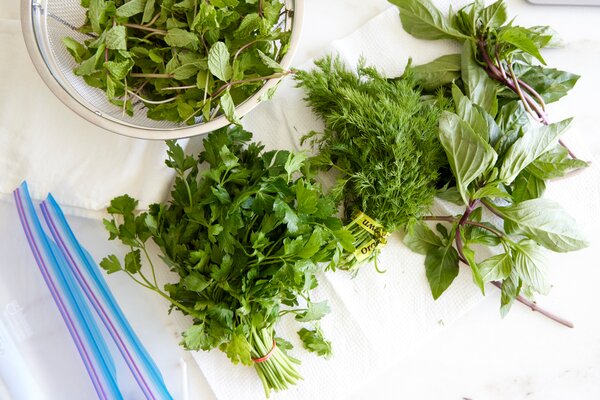Sad, wilting leaves? Never again with these easy expert suggestions.
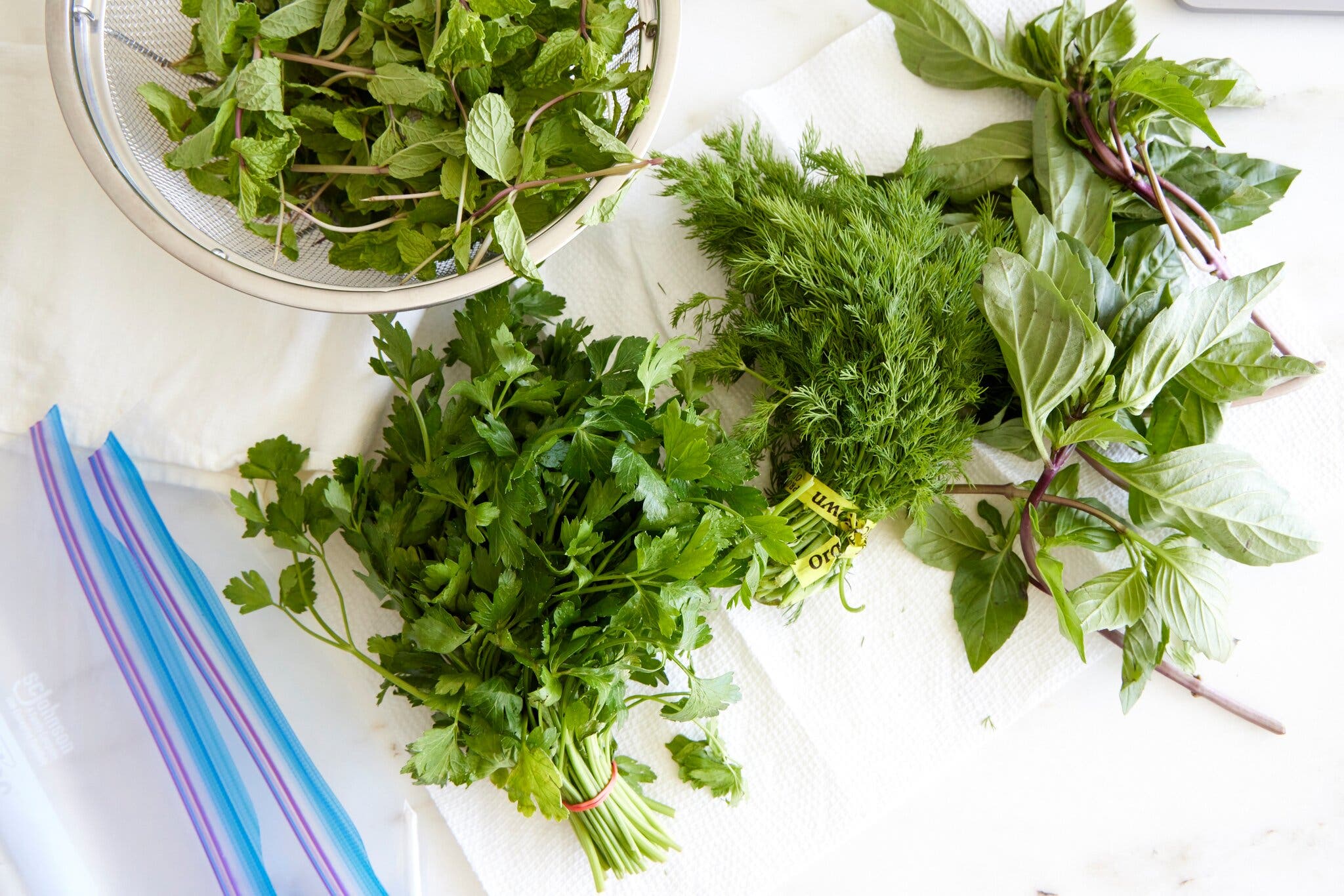
Have a glut of herbs? Prepare them smartly, then use them with abandon.Yossy Arefi for The New York Times (Photography and Styling)
At markets in the spring, abundant, well-priced bunches of herbs can be just as tempting as strawberries and asparagus. But bringing them home often means that one’s best intentions collide with the harsh realities: Herbs can go from sprightly to swampy before you have time to use them up. The simple tips that follow can help you make sure they never go to waste.
1. Choose your herbs wisely
Look for the freshest herbs you can find, which can last longer in the fridge and freezer, suggests Nasim Alikhani, the chef of Sofreh in Brooklyn, N.Y., and author of the cookbook “Sofreh.”
Herbs should be perky and vibrant, with plump, well-hydrated leaves and stems. (Avoid bunches with wilted, limp or waterlogged leaves, or discolored areas.) If possible, skip herbs in small plastic packages: Their condition can be hard to gauge.
2. Prep your herbs for storage right away

Make sure to rinse and dry your herbs well to set them up for success.Yossy Arefi for The New York Times (Photography and Styling)
Like flowers, herbs can’t wait to be released from their packaging. Once you’re home, spread out the loose herbs and pluck away any wilted or browned leaves that may have been hiding (the adage about rotten apples applies here, too).
“If you have one bit of cilantro leaf that’s been chewed up or damaged in some way, that’s going to be a focal point for bacteria,” said Donald W. Schaffner, a food microbiologist at Rutgers University.
Ms. Alikhani also likes to rinse her herbs before storing them, which has another advantage: You’ll be more likely to cook with herbs if you know they’re washed and ready to go. But make sure they’re well dried — Ms. Alikhani uses her salad spinner, but you can also blot them with paper towels — as “residual moisture will travel with the herbs,” contributing to bacterial growth, Dr. Schaffner said.
3. Keep soon-to-be-used herbs hydrated
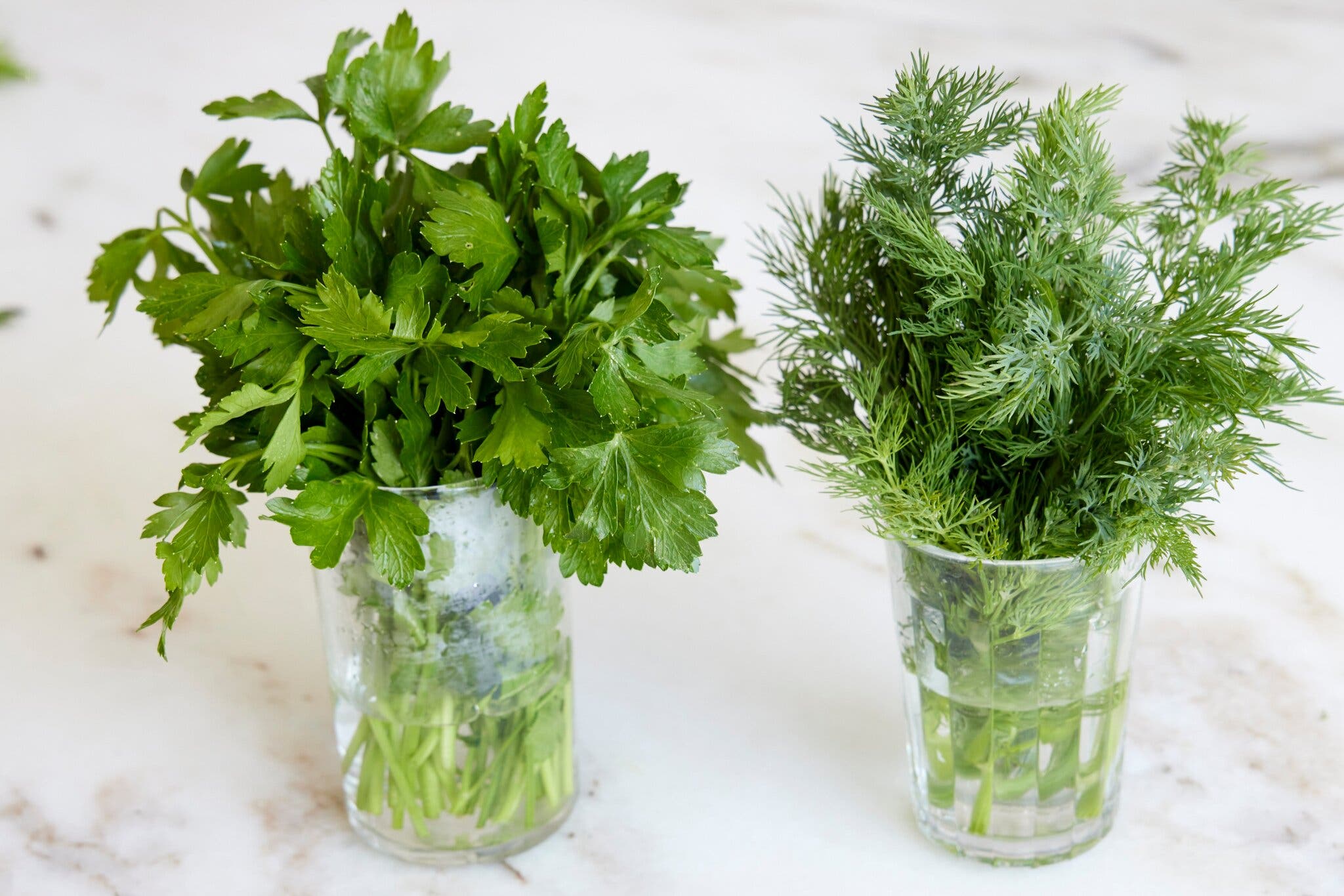
Keeping herbs in a glass of water is a solid strategy if using them on the sooner side.Yossy Arefi for The New York Times (Photography and Styling)
If you’re planning to use all your herbs in the next day or two (pesto, perhaps?), go for a simple approach. Ms. Alikhani just washes them without drying and adds them to a quart container of ice-cold water at the back of her fridge. To ensure the herbs absorb the water well, give the stem ends a trim before immersing them.
4. For longer storage, pack strategically
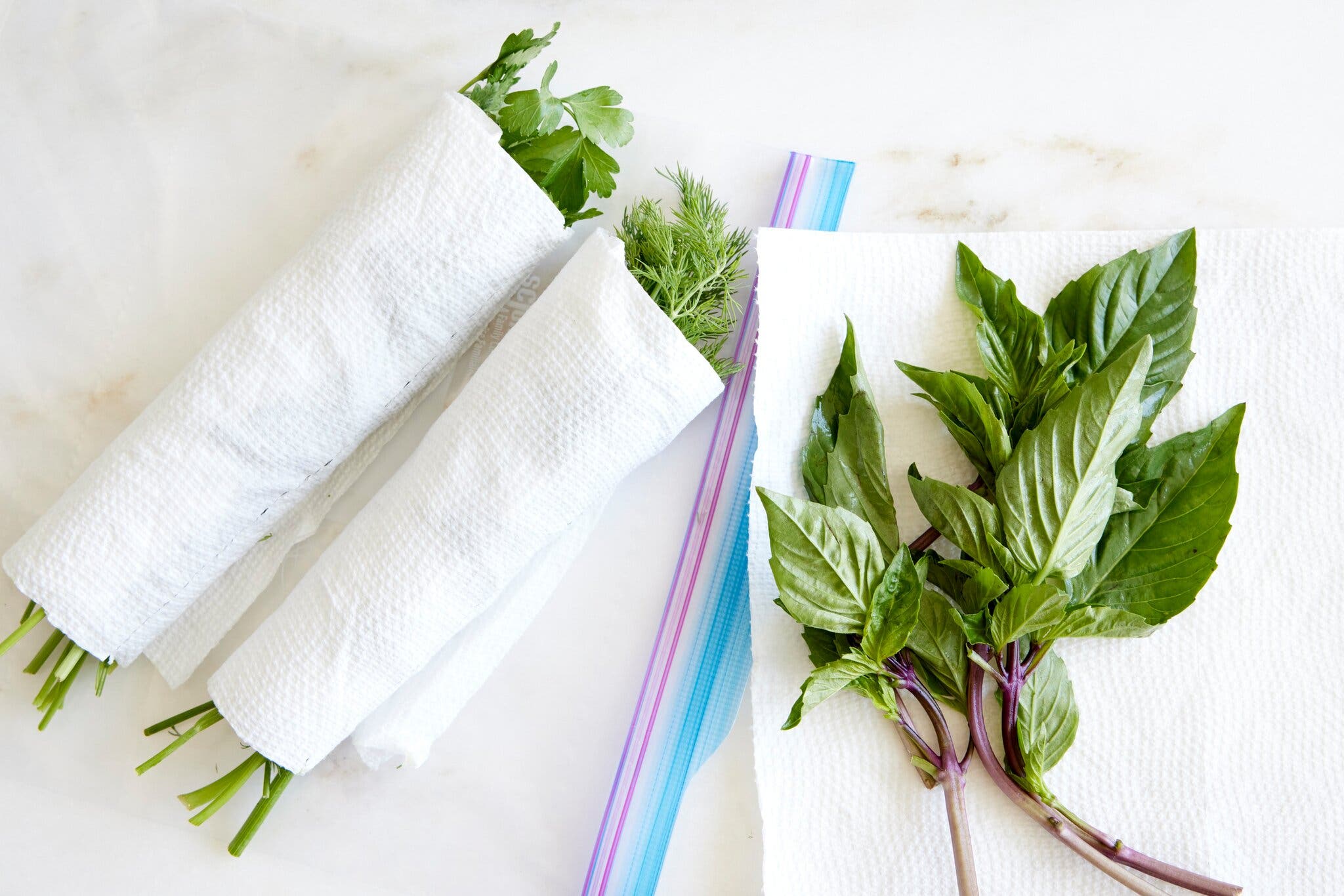
Wrapping well-dried herbs in a paper towel before tucking them into a resealable food storage bag in the fridge is one way of keeping herbs fresh.Yossy Arefi for The New York Times (Photography and Styling)
Herbs can keep in the fridge for one to two weeks. They’ll last longest when they have “enough moisture to keep them fresh but not so much moisture that they turn into a soupy, swampy mess,” Dr. Schaffner said.
To maintain that balance, Ms. Alikhani recommends wrapping well-dried herbs in a paper towel before tucking them into a resealable food storage bag in the fridge. But Dr. Schaffner cautions that may retain too much moisture. “My recommendation is just to make sure that everything is as dry as possible before placing into the bag,” he said. Whatever you choose, be sure to use a generously sized bag or container to ensure air circulation, and seal it well.
5. Handle living herbs with care
You might assume a plant will stay fresh longer than cut herbs, but without proper care, it can fade quickly. If you have herbs growing in your garden (or on your windowsill), aim to harvest them early in the day, and use sharp kitchen shears to avoid damaging them.
If bringing home a hydroponic plant, remove it from its wrapping, then trim any wilted leaves or mushy-looking roots. Place the plant in a jar with water coming up just past its roots, and set it on a windowsill that gets indirect sunlight. Change the water every day or two to keep the roots healthy.
6. Use herbs as vegetables, not just garnishes
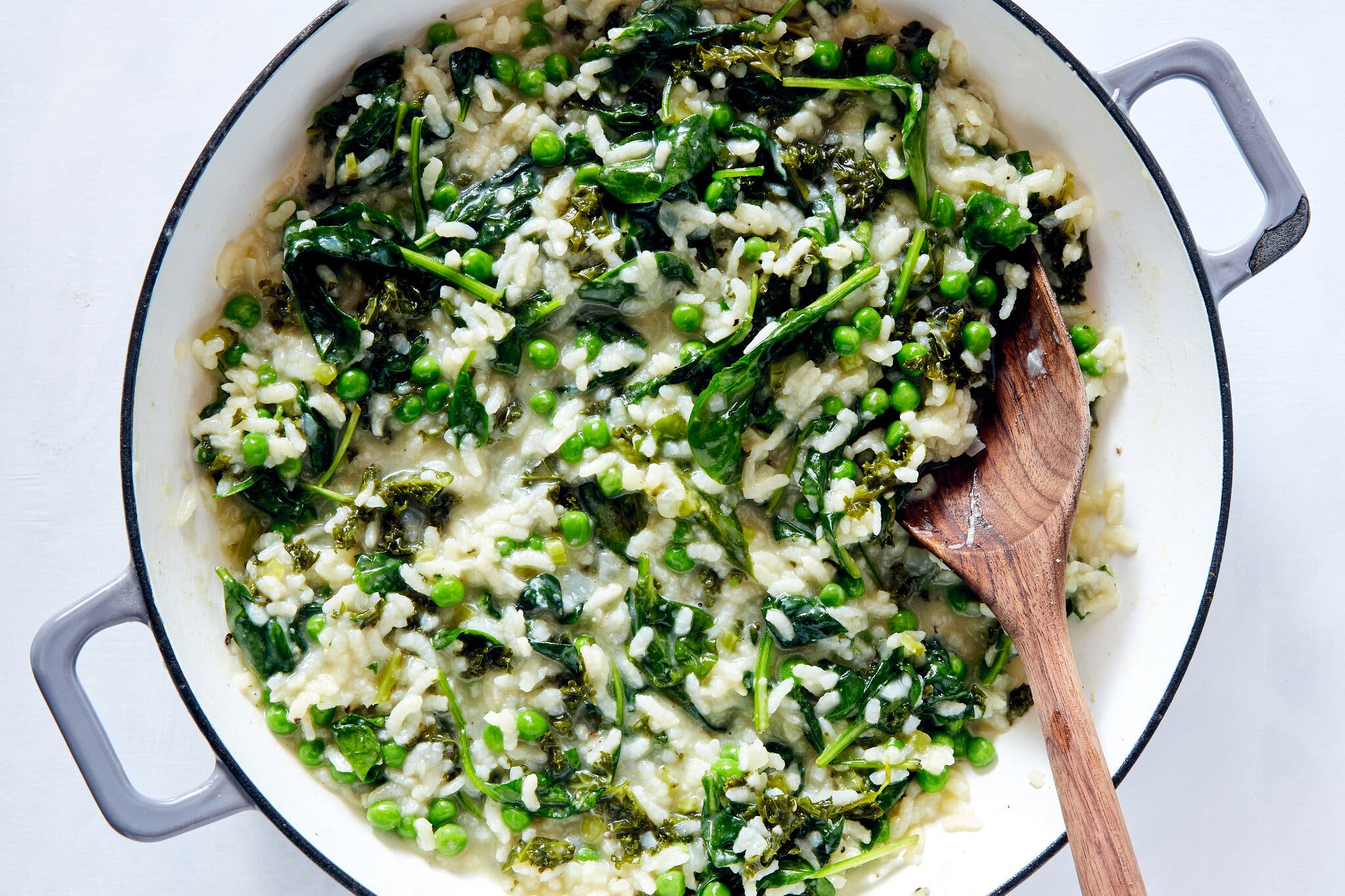
A risotto can be a great repository for lightly wilting greens and herbs. Yossy Arefi for The New York Times (Photography and Styling)
No matter how deftly you handle herbs, their freshness is fleeting, so use them with abandon while you have them. Persian cooks like Ms. Alikhani already tend to follow this approach: “We buy herbs by pounds in Iran,” she said. “They are not garnishes — they are our food.”
These strategies will help you use up your haul long before they wilt:
-
Stir handfuls of chopped herbs through … everything. Pots of warm rice, soup, stew, pasta or risotto turn instantly vibrant when finished with herbs.
-
Let them star in salads. Take a cue from Greek maroulosalata and add a generous helping of chopped dill, cilantro or parsley (including the tender stems) to your next salad. Or just make herb salad (a.k.a. tabbouleh).
-
Add herbs to ground-meat recipes. Stirring plenty of finely chopped herbs into ground-meat mixtures for meatballs, burgers and meatloaf doesn’t just add flavor — it also helps keep them tender when cooked.
-
Blend up an all-purpose green sauce. Creamy, silky, tangy or spicy green sauces tend to work with any combination of herbs. Use them as a marinade; a topping for grilled or roasted meat or seafood; or a dip for bread or vegetables.
-
When in doubt, turn to eggs. Frittata, quiche and savory egg pie would never say no to a handful of herbs. As kuku sabzi illustrates, egg recipes can go as green as you like.
-
If herbs are past their prime, cook them down. Even tired-looking herbs can still infuse longer-cooking dishes with flavor (and their texture isn’t as important, since they’ll soften up as they cook anyway). Take a cue from Andy Baraghani’s ash reshteh, a Persian greens and noodle soup, and add a pile of chopped herbs to a braise, stew or soup as it cooks.
7. When all else fails, freeze
Having fresh herbs is good, Ms. Alikhani said, “But is it essential? No, it is not.” When you’re caught without fresh herbs, “freezing them saves the cook’s life.”
Start by packing finely chopped herbs tightly into an ice cube tray, then fill the tray almost to the top with olive oil or water, freeze until solid, and transfer to resealable bags to keep in the freezer for up to two months. The oil-based cubes are handy for enriching soups, stews and pastas, while the water-based ones can quickly infuse a smoothie, lemonade or frozen cocktail with flavor.
If you’d rather not put anything but water in your ice cube trays, use a freezer bag instead: Mix chopped herbs with a few spoonfuls of oil and transfer to a freezer bag, pressing to flatten into a thin, even layer. The flat layer of herbs freezes especially fast, which can be an advantage. “If you’re going to freeze something, you want to try to freeze it as quickly as possible,” Dr. Schaffner said, to preserve quality. When ready to cook, simply break off a piece.
For a more straightforward option, bundle up an herb “cigar” of parsley, dill or cilantro, wrap in plastic and freeze. When you need chopped herbs for a recipe, use kitchen shears to quickly snip off what you need. It may not be the same as fresh, but the flavor still lasts.
Follow New York Times Cooking on Instagram, Facebook, YouTube, TikTok and Pinterest. Get regular updates from New York Times Cooking, with recipe suggestions, cooking tips and shopping advice.

